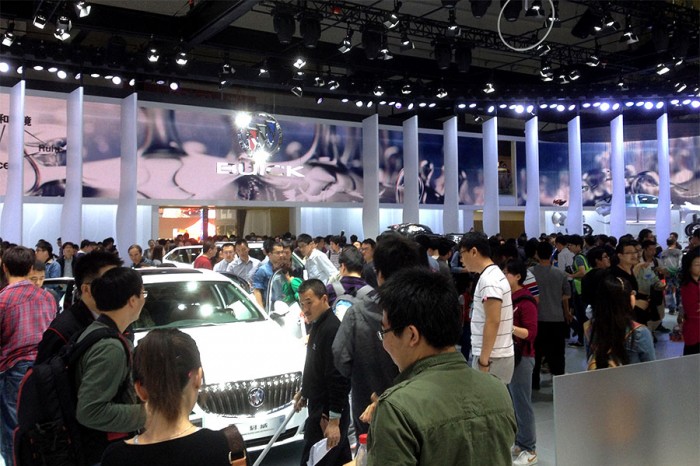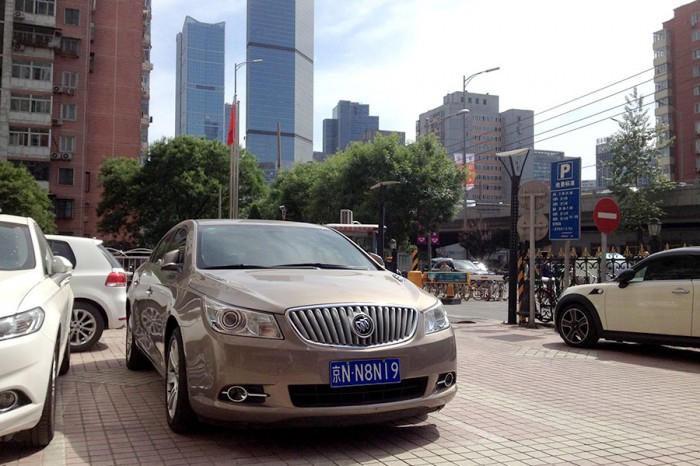Beijing—Wang Senghu slid into the seat of the sleek white sports car, eyeing the high-tech dashboard design. He had come to the auto show to upgrade his ride, and in a form-fitting black sweater, his hair closely cropped, he looked the part.
There was just one thing that seemed out of place: the car he coveted was a Buick.
“I think the business elite and people who are concerned about security drive Buicks,” said Wang, 30, who works in China’s fast-growing environmental protection industry. “I’ve seen American Buicks. People who drive them are business elites, too.”
In the United States, Buicks are more commonly associated with retirees than with hotshot young businessmen. But in Beijing, Buicks have cachet. It’s not uncommon to find a shiny Buick valet-parked proudly between an Audi and a Bentley outside a posh hotel, like Beijing’s Four Seasons.
Recently, the Chinese public got a preview of Buick’s latest cars at the Beijing Auto Show. Held at the China International Exhibition Center, a sprawling facility more than 15 miles from the city’s center, the show attracted nearly 1 million attendees.
The oldest surviving automobile make in America, Buick has long struggled to regain a foothold in the U.S. In 2005, GM vice chairman Bob Lutz called Buick a “damaged brand” during a conference at the New York Auto Show.
In 2009, General Motors dropped several makes while the company was in bankruptcy proceedings, including Saturn and Pontiac. But GM kept the Buick line, in large part because of the brand’s cachet in China.
And that cachet has paid off for GM. According to the car enthusiast magazine Car and Driver, the average Buick customer in China is a man in his mid-30s—about half the age of the average Buick customer in America.
In 2013, Buick sold more than 809,918 cars in the Chinese market—nearly four times as many as it sold in the U.S. That year, more than 78 percent of total Buick sales came from China. In its press release on those sales figures, the company touted 2013 as “best in brand’s 110-year history.” And in the first quarter of 2014, according to Forbes, Buick posted a nearly 14-percent increase in sales globally.
Buicks generally cost more in China than in the U.S. For 2014, the Buick LaCrosse 3.0 L V-6 SIDI IntelliTech Flagship costs 369,900 RMB, according to Autoweek, about $59,300,based on current exchange rates. The lowest cost Buick model in China is the LaCrosse 2.4L SIDI Pilot, which costs about $37,900. In comparison, the U.S. version of the 2014 LaCrosse sedan with a 2.4-liter engine has a sticker price of $34,060.
Buick markets itself as a luxury brand and it costs more than many Chinese cars. For example, General Motors operates in a joint venture to produce Wuling brand cars in China, including the Wuling Sunshine minivan—one of the most popular vehicles. One of the minivans—nicknamed the “bread box car” for its boxy shape, costs about $5,000.
Buick is certainly not alone in its efforts to woo Chinese consumers. Car traffic chokes the streets of China’s capital city, once known as the “kingdom of bicycles,” with an estimated 7.5 million drivers. Government statistics say the number of vehicles on China’s roads have more than doubled in the last decade.
As more Chinese climb into the middle class, the government has taken steps to manage the enormous growth. In 2011, the Chinese government created a license plate lottery system to restrict the number of new cars. McKinsey estimates that by 2020, the sales of premium cars in China, fueled by an estimated 23 million affluent urban households, will surpass those in the United States.
Buick is well positioned to cash in. The brand has a storied history in China that may explain part of its current resonance. In the early 20th century, several of the county’s elite drove, or were driven in, Buicks, including Pu Yi, the country’s last emperor until his abdication in 1912; Sun Yat-sen, the founding father of the Republic of China; and Zhou Enlai, China’s premier until 1976.
On April 26, the first Saturday the auto show opened to the public, traffic crawled along the highway leading to the Exhibition Center. Crowds at the nearest subway station snaked like the entrance to a Disney theme park. People waited in long security lines in the sun for their tickets to be scanned.

The car displays varied widely. One showed an enormous SUV crawling over giant boulders—more African safari than Beijing commuter. Another display featured a woman leaning sensuously over the hood of an SUV, toying with her hair as dozens of people crowded around her. In another exhibition hall, dancers whirled around a Chinese-brand car as music pounded.
The Buick display featured neither rocks nor models. It was simple and sleek. As white fan-like blades slowly rotated along the walls, hundreds of people examined the cars, opening the trunks, sitting inside and snapping photos.
Zhou Jiong, 40, and his wife, Shi Chunyu, 37, wandered through the showroom, looking at minivans and SUVs on display. Zhou, who works in engineering project management, said he’s heard about Buicks through his friends and from online ads.
“I think Buick as a brand in China is very trustworthy,” he said.
His wife, who works in online media, sounded smitten. “I think it’s a business people’s car. It’s stylish, fashionable and dynamic. I was attracted at first glance.”
Both said they had no idea what kind of person drove a Buick in America.
Nearby, Cheng Qingyong, 40, examined the trunk of a Buick sedan. In a smart gray suit, the businessman currently owns a Japanese car, but he said he’s interested in Buicks.
What sort of person drives a Buick? “A big boss,” he said. “My boss drives a Buick.” As for who drives it in America, he doesn’t know and says he’s not curious to know.
But a young couple walking past, Guo Tingting, 32, and Li Gang, 34, were intrigued. Guo, who works in human resources, said she learned about Buicks by watching American television dramas, such as Criminal Minds.
“We tend to think, for people our age, we like American cars—they are stylish, spacious,” she said.
When they hear that Buicks are better known for the early bird special set than Hollywood starlets, they both laugh.
So did Wang, who says he’s seen Buicks on his favorite American drama, Prison Break.
But they all immediately turned back to browsing the shiny showroom, their eyes fixed on all those brand new Buicks.
Sophie Zheng contributed with interview translation for this story.



Today’s Buick cars look every bit as nice as Lexus, Acura, Lincoln and Infinity. Too bad that the brand has such a pathetic, old man image.
@Stephen
“Too bad that the brand has such a pathetic, old man image.”
Only some “pathetic” Americans, with no taste, thinks that BS. Today, I see more Buicks now (especially the Enclave, it’s very popular now in the U.S.) on the road today in the U.S, than 10 years ago.